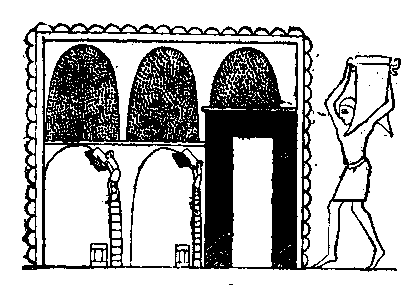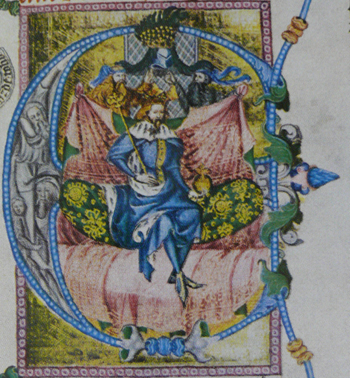|
New Town (Prague)
The New Town ( cs, Nové Město) is a quarter in the city of Prague in the Czech Republic. New Town is the youngest and largest of the five independent (from the Middle Ages until 1784) towns that today comprise the historic center of modern Prague. New Town was founded in 1348 by Charles IV just outside the city walls to the east and south of the Old Town and encompassed an area of 7.5 km²; about three times the size of the Old Town. The population of Prague in 1378 was well over 40,000, perhaps as much as twice that, making it the 4th most populated city north of the Alps and, by area, the 3rd largest city in Europe. Although New Town can trace its current layout to its construction in the 14th century, only few churches and administrative buildings from this time survive. There are many secular and educational buildings in New Town, but also especially magnificent gothic and baroque churches. These nevertheless are not the main drawing points for tourists. New Town's most ... [...More Info...] [...Related Items...] OR: [Wikipedia] [Google] [Baidu] |
Prague 07-2016 Mezibranska
Prague ( ; cs, Praha ; german: Prag, ; la, Praga) is the capital and largest city in the Czech Republic, and the historical capital of Bohemia. On the Vltava river, Prague is home to about 1.3 million people. The city has a temperate oceanic climate, with relatively warm summers and chilly winters. Prague is a political, cultural, and economic hub of central Europe, with a rich history and Romanesque, Gothic, Renaissance and Baroque architectures. It was the capital of the Kingdom of Bohemia and residence of several Holy Roman Emperors, most notably Charles IV (r. 1346–1378). It was an important city to the Habsburg monarchy and Austro-Hungarian Empire. The city played major roles in the Bohemian and the Protestant Reformations, the Thirty Years' War and in 20th-century history as the capital of Czechoslovakia between the World Wars and the post-war Communist era. Prague is home to a number of well-known cultural attractions, many of which survived the violenc ... [...More Info...] [...Related Items...] OR: [Wikipedia] [Google] [Baidu] |
Vyšehrad
Vyšehrad (Czech for "upper castle") is a historic fort in Prague, Czech Republic, just over 3 km southeast of Prague Castle, on the east bank of the Vltava River. It was probably built in the 10th century. Inside the fort are the Basilica of St. Peter and St. Paul and the Vyšehrad Cemetery, containing the remains of many famous Czechs, such as Antonín Dvořák, Bedřich Smetana, Karel Čapek, and Alphonse Mucha. It also contains Prague's oldest Rotunda of St. Martin, from the 11th century. History Local legend holds that Vyšehrad was the location of the first settlement which later became Prague, though thus far this claim remains unsubstantiated. Legend has it that Duke Krok founded Vyšehrad while looking for a safer seat than in Budeč. On a steep rock above the Vltava river, he ordered a forest to be cut down and a castle built there. Also according to legend, Prince Křesomysl imprisoned the knight Horymír at Vyšehrad because he damaged silver mines, and Hor ... [...More Info...] [...Related Items...] OR: [Wikipedia] [Google] [Baidu] |
Dancing House
The Dancing House ( cs, Tančící dům), or Fred and Ginger, is the nickname given to the Nationale-Nederlanden building on the Rašínovo nábřeží ( Rašín Embankment) in Prague, Czech Republic. It was designed by the Croatian-Czech architect Vlado Milunić in cooperation with Canadian-American architect Frank Gehry on a vacant riverfront plot. The building was designed in 1992. The construction, carried out by BESIX, was completed four years later in 1996. Gehry originally called the house ''Fred and Ginger'' (after the dancers Fred Astaire and Ginger Rogers – the house resembles a pair of dancers) but this nickname is now rarely used. Gehry himself later discarded his own idea, as he was "afraid to import American Hollywood kitsch to Prague". Origin The "Dancing House" is set on a property of great historical significance. Its site was the location of a house destroyed by the U.S. bombing of Prague in 1945. The plot and structure lay decrepit until 1960, when the are ... [...More Info...] [...Related Items...] OR: [Wikipedia] [Google] [Baidu] |
Na Karlově
NA, N.A., Na, nA or n/a may refer to: Chemistry and physics * Sodium, symbol Na, a chemical element * Avogadro constant (''N''A) * Nucleophilic addition, a type of reaction in organic chemistry * Numerical aperture, a number that characterizes a range of angles in an optical system * nA, the symbol for nanoampere * Naturally aspirated engine Biology and medicine * Na (tree) or ''Mesua ferrea'', a species of tree native to Sri Lanka * Neuroacanthocytosis, a neurological condition * ''Nomina Anatomica'', a former international standard for human anatomical nomenclature * Noradrenaline, a hormone * Nucleic acid analogue, compounds analogous to naturally occurring RNA and DNA Places Current * Namibia (ISO country code) * Naples (car number plate code: NA), Italy * North America, a continent * North Africa, a subcontinent Historical * Netherlands Antilles (former international vehicle registration code: NA) * Na (Chinese state), a small state of the Chinese Zhou dynasty from the 1 ... [...More Info...] [...Related Items...] OR: [Wikipedia] [Google] [Baidu] |
Grain Trade
The grain trade refers to the local and international trade in cereals and other food grains such as wheat, barley, maize, and rice. Grain is an important trade item because it is easily stored and transported with limited spoilage, unlike other agricultural products. Healthy grain supply and trade is important to many societies, providing a caloric base for most food systems as well as important role in animal feed for animal agriculture. The grain trade is as old as agricultural settlement, identified in many of the early cultures that adopted sedentary farming. Major societal changes have been directly connected to the grain trade, such as the fall of the Roman Empire. From the early modern period onward, grain trade has been an important part of colonial expansion and international power dynamics. The geopolitical dominance of countries like Australia, the United States, Canada and the Soviet Union during the 20th century was connected with their status as grain surplus c ... [...More Info...] [...Related Items...] OR: [Wikipedia] [Google] [Baidu] |
Powder Gate
The Powder Tower or Powder Gate ( cs, Prašná brána) is a Gothic tower in Prague, Czech Republic. It is one of the original city gates. It separates the Old Town from the New Town. History The Powder Tower is one of the original 13 city gates in Old Town, Prague. Its construction began in 1475. The tower was intended to be an attractive entrance into the city, instead of a defensive tower. The foundation stone was placed by Vladislav II. The city council gave Vladislav II the tower as a coronation gift. While it was being built, it was called the New Tower. The look of the tower was inspired by the work of Peter Parler on the Charles Bridge. Vladislav II had to relocate due to riots, so the tower building stopped. He returned in 1485 to live back in Prague Castle, where he lived for the rest of his life, along with the rest of the Kings of Bohemia who lived in Prague. Kings would not return to use the tower or Royal Court until using it for coronation ceremonies start ... [...More Info...] [...Related Items...] OR: [Wikipedia] [Google] [Baidu] |
Botanical Garden
A botanical garden or botanic gardenThe terms ''botanic'' and ''botanical'' and ''garden'' or ''gardens'' are used more-or-less interchangeably, although the word ''botanic'' is generally reserved for the earlier, more traditional gardens, and is the more usual term in the United Kingdom. is a garden with a documented collection of living plants for the purpose of scientific research, conservation, display, and education. Typically plants are labelled with their botanical names. It may contain specialist plant collections such as cactus, cacti and other succulent plants, herb gardens, plants from particular parts of the world, and so on; there may be greenhouses, shadehouses, again with special collections such as tropical plants, alpine plants, or other exotic plants. Most are at least partly open to the public, and may offer guided tours, educational displays, art exhibitions, book rooms, open-air theatrical and musical performances, and other entertainment. Botanical gard ... [...More Info...] [...Related Items...] OR: [Wikipedia] [Google] [Baidu] |
Wenceslas IV
Wenceslaus IV (also ''Wenceslas''; cs, Václav; german: Wenzel, nicknamed "the Idle"; 26 February 136116 August 1419), also known as Wenceslaus of Luxembourg, was King of Bohemia from 1378 until his death and King of Germany from 1376 until he was deposed in 1400. As he belonged to the House of Luxembourg, he was also Duke of Luxembourg from 1383 to 1388. Biography Wenceslaus was born in the Imperial city of Nuremberg, the son of Emperor Charles IV by his third wife Anna von Schweidnitz, a scion of the Silesian Piasts, and baptized at St. Sebaldus Church. He was raised by the Prague Archbishops Arnošt of Pardubice and Jan Očko of Vlašim. His father had the two-year-old crowned King of Bohemia in June 1363 and in 1373 also obtained for him the Electoral Margraviate of Brandenburg. When on 10 June 1376 Charles IV asserted Wenceslaus' election as King of the Romans by the prince-electors, two of seven votes, those of Brandenburg and Bohemia, were held by the emp ... [...More Info...] [...Related Items...] OR: [Wikipedia] [Google] [Baidu] |
Hussite Revolution
The Hussite Wars, also called the Bohemian Wars or the Hussite Revolution, were a series of civil wars fought between the Hussites and the combined Catholic forces of Holy Roman Emperor Sigismund, the Papacy, European monarchs loyal to the Catholic Church, as well as various Hussite factions. At a late stage of the conflict, the Utraquists changed sides in 1432 to fight alongside Roman Catholics and opposed the Taborites and other Hussite spinoffs. These wars lasted from 1419 to approximately 1434. The unrest began after pre-Protestant Christian reformer Jan Hus was executed by the Catholic Church in 1415 for heresy. Because the King Wenceslaus IV of Bohemia had plans to be crowned the Holy Roman Emperor (requiring Papal Coronation), he suppressed the religion of the Hussites, yet it continued to spread. When King Wenceslaus IV died of natural causes a few years later, the tension stemming from the Hussites grew stronger. In Prague and various other parts of Bohemia, the Cathol ... [...More Info...] [...Related Items...] OR: [Wikipedia] [Google] [Baidu] |
Avignon
Avignon (, ; ; oc, Avinhon, label=Provençal dialect, Provençal or , ; la, Avenio) is the Prefectures in France, prefecture of the Vaucluse Departments of France, department in the Provence-Alpes-Côte d'Azur Regions of France, region of Southeastern France. Located on the left bank of the river Rhône, the Communes of France, commune had a population of 93,671 as of the census results of 2017, with about 16,000 (estimate from Avignon's municipal services) living in the ancient town centre enclosed by its Walls of Avignon, medieval walls. It is Functional area (France), France's 35th largest metropolitan area according to Institut national de la statistique et des études économiques, INSEE with 336,135 inhabitants (2019), and France's 13th largest urban unit with 458,828 inhabitants (2019). Its urban area was the fastest-growing in France from 1999 until 2010 with an increase of 76% of its population and an area increase of 136%. The Communauté d'agglomération du Grand Av ... [...More Info...] [...Related Items...] OR: [Wikipedia] [Google] [Baidu] |




